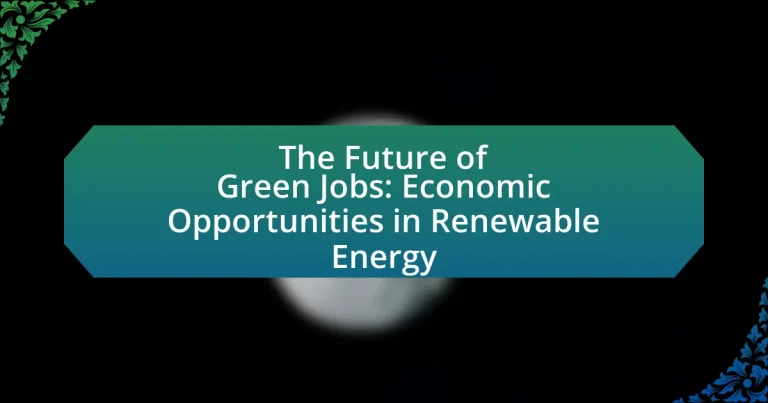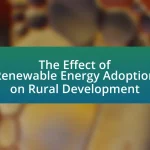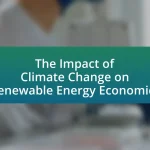Green jobs are employment opportunities that focus on preserving or restoring the environment, particularly in sectors such as renewable energy, energy efficiency, waste management, and sustainable agriculture. The article explores the significance of green jobs for future economic growth, highlighting their potential to create millions of new jobs globally by 2030. It discusses the impact of renewable energy on job creation, the skills required for these positions, and the educational pathways available. Additionally, the article addresses the challenges facing the green jobs market, the role of government policies, and the importance of community initiatives in preparing for a sustainable workforce. Overall, it emphasizes the economic opportunities presented by the transition to a greener economy and the emerging trends that will shape the future of green jobs.

What are Green Jobs and Why are They Important for the Future?
Green jobs are employment opportunities that contribute to preserving or restoring the environment, primarily in sectors such as renewable energy, energy efficiency, waste management, and sustainable agriculture. These jobs are important for the future because they play a crucial role in combating climate change, promoting sustainable economic growth, and creating a resilient workforce. According to the International Labour Organization, transitioning to a greener economy could create 24 million new jobs globally by 2030, highlighting the significant economic potential of green jobs.
How do Green Jobs contribute to economic growth?
Green jobs contribute to economic growth by creating new employment opportunities in sectors focused on sustainability and renewable energy. These jobs stimulate investment in green technologies, which can lead to increased productivity and innovation. For instance, the International Renewable Energy Agency reported that the renewable energy sector employed over 11 million people globally in 2018, demonstrating significant job creation potential. Additionally, green jobs often lead to the development of local economies, as they require local resources and services, thereby enhancing community resilience and economic diversification.
What sectors are most impacted by the rise of Green Jobs?
The sectors most impacted by the rise of Green Jobs include renewable energy, energy efficiency, waste management, and sustainable agriculture. Renewable energy, particularly solar and wind, has seen significant job growth, with the International Renewable Energy Agency reporting over 11 million jobs globally in this sector as of 2018. Energy efficiency initiatives have also created numerous positions in building retrofitting and smart technology implementation. Waste management has evolved to include recycling and composting jobs, reflecting a shift towards circular economy practices. Sustainable agriculture is increasingly incorporating green practices, leading to job creation in organic farming and agroecology. These sectors are transforming the job landscape by prioritizing sustainability and environmental responsibility.
How do Green Jobs influence local economies?
Green jobs significantly influence local economies by creating employment opportunities, stimulating economic growth, and promoting sustainable practices. These jobs, particularly in renewable energy sectors such as solar and wind, contribute to local economies by generating direct employment; for instance, the U.S. solar industry employed over 250,000 workers in 2019, reflecting a 167% increase since 2010. Additionally, green jobs often lead to increased local investment, as businesses in renewable energy require local services and infrastructure, thereby boosting local suppliers and service providers. Furthermore, the transition to green jobs can enhance community resilience by reducing dependence on fossil fuels, which can lead to more stable local economies.
What role does renewable energy play in the creation of Green Jobs?
Renewable energy is a significant driver in the creation of Green Jobs, as it fosters employment opportunities in sectors such as solar, wind, and bioenergy. The International Renewable Energy Agency (IRENA) reported that the renewable energy sector employed over 11 million people globally in 2018, with projections indicating continued growth as investments in clean energy technologies increase. This growth is attributed to the demand for skilled labor in manufacturing, installation, maintenance, and research and development of renewable energy systems, which collectively contribute to a sustainable economy and job creation.
What types of renewable energy sources are driving job growth?
Solar energy and wind energy are the primary renewable energy sources driving job growth. The solar industry has seen significant expansion, with the U.S. solar workforce growing to over 250,000 jobs by 2021, according to the Solar Foundation’s National Solar Jobs Census. Similarly, the wind energy sector has also experienced rapid growth, employing approximately 116,000 workers in the U.S. as of 2020, as reported by the U.S. Department of Energy. These sectors are not only creating jobs in installation and maintenance but also in manufacturing and research and development, contributing to a robust green economy.
How does technology advancement in renewable energy affect job opportunities?
Technology advancement in renewable energy significantly increases job opportunities by creating new roles in research, development, installation, and maintenance of renewable energy systems. For instance, the International Renewable Energy Agency (IRENA) reported that the renewable energy sector employed over 11 million people globally in 2018, and this number is projected to grow as technology improves efficiency and reduces costs. Additionally, advancements in solar and wind technologies have led to a surge in demand for skilled workers, such as engineers and technicians, further expanding the job market.
What skills are required for Green Jobs in the renewable energy sector?
Green jobs in the renewable energy sector require technical skills, project management abilities, and knowledge of environmental regulations. Technical skills include proficiency in renewable technologies such as solar, wind, and bioenergy systems, which are essential for installation and maintenance. Project management skills are necessary to oversee renewable energy projects from conception to completion, ensuring they meet deadlines and budgets. Knowledge of environmental regulations is crucial for compliance and to promote sustainable practices. According to the International Renewable Energy Agency, the renewable energy sector is projected to create 24 million jobs globally by 2030, highlighting the demand for these specific skills.
What educational pathways lead to careers in Green Jobs?
Educational pathways leading to careers in Green Jobs include degrees in environmental science, renewable energy technology, and sustainability studies. These programs equip students with knowledge in ecological principles, energy systems, and sustainable practices, which are essential for roles in the growing green economy. For instance, a report by the U.S. Bureau of Labor Statistics indicates that jobs in renewable energy are projected to grow significantly, highlighting the demand for skilled professionals in this sector. Additionally, certifications in energy management and green building can further enhance employability in green job markets.
How can workers transition from traditional jobs to Green Jobs?
Workers can transition from traditional jobs to Green Jobs by acquiring relevant skills through education and training programs focused on renewable energy and sustainability. Many community colleges and vocational schools offer courses in solar panel installation, wind turbine maintenance, and energy efficiency, which are essential for entering the green workforce. According to the U.S. Bureau of Labor Statistics, employment in green jobs is projected to grow significantly, with roles in renewable energy expected to increase by 11% from 2019 to 2029. This growth highlights the demand for skilled workers in the sector, making targeted training programs a viable pathway for those looking to shift careers.
How can businesses leverage Green Jobs for sustainability?
Businesses can leverage Green Jobs for sustainability by integrating environmentally focused roles into their operations, which enhances their ecological footprint and promotes renewable energy initiatives. By hiring professionals in sectors such as solar energy, wind energy, and sustainable agriculture, companies can reduce carbon emissions and improve energy efficiency. For instance, a report from the International Renewable Energy Agency (IRENA) indicates that the renewable energy sector employed over 11 million people globally in 2018, demonstrating the potential for job creation while advancing sustainability goals. Additionally, investing in training programs for employees in green technologies can lead to innovation and improved practices, further solidifying a company’s commitment to sustainability.
What policies are necessary to support the growth of Green Jobs?
To support the growth of Green Jobs, policies must focus on investment in renewable energy, education and training programs, and incentives for sustainable practices. Investment in renewable energy infrastructure, such as solar and wind projects, can create job opportunities; for instance, the International Renewable Energy Agency reported that the renewable energy sector employed over 11 million people globally in 2018. Education and training programs are essential to equip the workforce with necessary skills; the U.S. Department of Energy has emphasized the importance of workforce development in clean energy sectors. Additionally, providing tax incentives and subsidies for businesses that adopt green technologies can stimulate job creation in this field, as evidenced by the success of programs like the Investment Tax Credit, which has significantly boosted solar energy installations and related employment.

What are the Economic Opportunities in Renewable Energy?
Economic opportunities in renewable energy include job creation, investment potential, and technological innovation. The renewable energy sector is projected to create 24 million jobs globally by 2030, according to the International Renewable Energy Agency (IRENA). This growth is driven by increasing demand for clean energy sources, such as solar, wind, and hydropower, which require skilled labor for installation, maintenance, and operation. Additionally, investments in renewable energy technologies are expected to reach $2.6 trillion by 2025, as governments and private sectors prioritize sustainable energy solutions. This shift not only fosters economic growth but also enhances energy security and reduces reliance on fossil fuels.
How does investment in renewable energy create job opportunities?
Investment in renewable energy creates job opportunities by driving the demand for skilled labor in various sectors such as manufacturing, installation, and maintenance of renewable energy technologies. For instance, the International Renewable Energy Agency reported that the renewable energy sector employed over 11 million people globally in 2018, with significant growth projected as investments increase. This growth is fueled by the expansion of solar, wind, and other renewable technologies, which require a workforce for production, installation, and ongoing support. Additionally, investments in renewable energy stimulate local economies, leading to indirect job creation in related industries such as construction, transportation, and services.
What are the financial benefits of investing in renewable energy?
Investing in renewable energy offers significant financial benefits, including reduced energy costs, job creation, and long-term economic stability. Renewable energy sources, such as solar and wind, have lower operational costs compared to fossil fuels, leading to decreased energy bills for consumers and businesses. According to the International Renewable Energy Agency (IRENA), the renewable energy sector employed over 11 million people globally in 2018, and this number is projected to grow as investments increase, further stimulating economic growth. Additionally, renewable energy investments contribute to energy independence, reducing reliance on imported fuels and enhancing national security.
How do government incentives impact job creation in renewable energy?
Government incentives significantly enhance job creation in renewable energy by providing financial support and regulatory frameworks that stimulate investment and development in the sector. For instance, the International Renewable Energy Agency reported that global renewable energy jobs reached 11.5 million in 2018, largely driven by government policies such as tax credits, grants, and subsidies that lower the cost of renewable technologies. These incentives encourage companies to expand operations, hire more workers, and innovate, leading to a robust job market in areas like solar, wind, and bioenergy. Additionally, a study by the National Renewable Energy Laboratory found that every $1 million invested in renewable energy creates approximately 7.49 jobs, illustrating the direct correlation between government support and employment growth in this industry.
What are the challenges facing the Green Jobs market?
The Green Jobs market faces several significant challenges, including a lack of skilled workforce, inconsistent policy support, and limited access to funding. The shortage of trained professionals in renewable energy sectors hampers growth, as evidenced by a report from the International Renewable Energy Agency, which indicates that 24 million jobs could be created by 2030 if the necessary skills are developed. Inconsistent government policies create uncertainty for investors and businesses, leading to hesitance in committing resources to green initiatives. Additionally, access to funding remains a barrier, particularly for startups and small businesses in the green sector, as highlighted by the World Bank, which notes that financing gaps can hinder innovation and expansion.
How do economic fluctuations affect the stability of Green Jobs?
Economic fluctuations significantly impact the stability of Green Jobs by influencing investment levels and demand for renewable energy technologies. During economic downturns, funding for green initiatives often decreases, leading to job losses and project cancellations in the renewable sector. For instance, a report from the International Renewable Energy Agency (IRENA) indicated that global renewable energy jobs fell by 11% in 2020 due to the COVID-19 pandemic, highlighting the vulnerability of green employment to economic conditions. Conversely, during periods of economic growth, increased investments in sustainable technologies can lead to job creation and stability in the green sector, as seen in the 2010s when global investments in renewable energy surged, resulting in a significant rise in green jobs. Thus, the cyclical nature of economic conditions directly correlates with the stability and growth potential of Green Jobs.
What barriers exist for workers entering the Green Jobs sector?
Barriers for workers entering the Green Jobs sector include a lack of relevant skills, limited access to training programs, and insufficient awareness of job opportunities. Many potential workers do not possess the technical skills required for green jobs, as highlighted by a report from the International Renewable Energy Agency, which states that 40% of employers in the renewable energy sector struggle to find qualified candidates. Additionally, training programs are often not widely available or accessible, particularly in underserved communities, which exacerbates the skills gap. Furthermore, there is often a lack of information regarding available positions in the green economy, leading to missed opportunities for job seekers.
How can communities prepare for the future of Green Jobs?
Communities can prepare for the future of Green Jobs by investing in education and training programs focused on renewable energy skills. These programs can equip the workforce with the necessary expertise to meet the growing demand for green technologies, which is projected to create millions of jobs globally. According to the International Renewable Energy Agency, the renewable energy sector employed over 11 million people worldwide in 2018, and this number is expected to rise significantly as countries transition to sustainable energy sources. By fostering partnerships with local businesses and educational institutions, communities can develop tailored training initiatives that align with the specific needs of the green economy, ensuring that residents are well-prepared for emerging job opportunities.
What initiatives can local governments implement to promote Green Jobs?
Local governments can implement initiatives such as establishing green job training programs, providing incentives for businesses that create sustainable jobs, and investing in renewable energy projects. Training programs equip the workforce with necessary skills for green industries, which is essential as the U.S. Bureau of Labor Statistics projects that employment in renewable energy sectors will grow significantly in the coming years. Incentives, such as tax breaks or grants, encourage businesses to hire and train workers in green jobs, fostering economic growth while addressing environmental concerns. Additionally, investing in renewable energy infrastructure, such as solar and wind projects, not only creates immediate job opportunities but also supports long-term sustainability goals, aligning with the global shift towards a greener economy.
How can education systems adapt to meet the demand for Green Jobs?
Education systems can adapt to meet the demand for Green Jobs by integrating sustainability-focused curricula and vocational training programs. This adaptation involves updating educational content to include renewable energy technologies, environmental science, and sustainable practices, which are essential for preparing students for careers in green sectors. For instance, the International Renewable Energy Agency (IRENA) reported that the renewable energy sector could create 24 million jobs globally by 2030, highlighting the urgent need for a workforce equipped with relevant skills. Additionally, partnerships between educational institutions and industry leaders can facilitate internships and hands-on training, ensuring that students gain practical experience in green technologies.

What are the Future Trends in Green Jobs and Renewable Energy?
Future trends in green jobs and renewable energy include significant growth in sectors such as solar and wind energy, driven by technological advancements and policy support. The International Renewable Energy Agency (IRENA) reported that the renewable energy sector employed over 11 million people globally in 2018, with projections indicating this number could reach 24 million by 2030 as countries transition to sustainable energy sources. Additionally, the rise of electric vehicles and energy efficiency technologies is expected to create millions of new jobs in manufacturing, installation, and maintenance. The shift towards a circular economy will also enhance job opportunities in recycling and waste management related to renewable technologies.
How is the job market for Green Jobs expected to evolve in the next decade?
The job market for Green Jobs is expected to grow significantly over the next decade, driven by increasing investments in renewable energy and sustainability initiatives. According to the International Renewable Energy Agency (IRENA), the global renewable energy sector could create up to 24 million jobs by 2030, reflecting a shift towards cleaner energy sources and technologies. This growth is fueled by government policies aimed at reducing carbon emissions and transitioning to a low-carbon economy, as well as rising consumer demand for sustainable products and services. The expansion of sectors such as solar, wind, and energy efficiency will be pivotal in shaping the job landscape, leading to a diverse range of employment opportunities in engineering, installation, maintenance, and research.
What emerging technologies are likely to create new Green Jobs?
Emerging technologies likely to create new Green Jobs include renewable energy technologies, energy storage systems, electric vehicles, and smart grid technologies. Renewable energy technologies, such as solar and wind power, are expanding rapidly; for instance, the International Renewable Energy Agency reported that solar jobs alone grew by 167% from 2010 to 2020. Energy storage systems, particularly battery technologies, are essential for managing renewable energy supply and demand, leading to job creation in manufacturing and installation. The electric vehicle market is projected to create millions of jobs in manufacturing, maintenance, and infrastructure development, as evidenced by a report from the International Council on Clean Transportation, which estimates that the U.S. could see over 1 million jobs in the EV sector by 2030. Smart grid technologies enhance energy efficiency and reliability, driving job growth in software development and system integration. These technologies collectively contribute to a sustainable economy and the creation of diverse employment opportunities.
How will climate change policies influence the future of Green Jobs?
Climate change policies will significantly enhance the future of Green Jobs by driving investment in renewable energy sectors. These policies, such as carbon pricing and renewable energy mandates, create a regulatory framework that incentivizes businesses to transition towards sustainable practices. For instance, the International Renewable Energy Agency reported that the renewable energy sector employed over 11 million people globally in 2018, and this number is projected to grow as governments implement stricter climate policies. Furthermore, the U.S. Bureau of Labor Statistics anticipates that jobs in solar and wind energy will grow by 20% and 61%, respectively, from 2019 to 2029, largely due to supportive climate legislation. Thus, climate change policies are pivotal in shaping a robust job market focused on sustainability and environmental stewardship.
What best practices can individuals follow to pursue a career in Green Jobs?
Individuals can pursue a career in Green Jobs by acquiring relevant education and skills in sustainability and renewable energy. Engaging in specialized training programs, such as those offered by institutions like the Solar Energy International, can provide practical knowledge and certifications that are highly valued in the green job market. Networking with professionals in the field through organizations like the Green Jobs Network can also enhance job prospects. Additionally, staying informed about industry trends and participating in internships or volunteer opportunities can provide hands-on experience, making candidates more competitive. According to the U.S. Bureau of Labor Statistics, employment in green jobs is projected to grow significantly, highlighting the importance of these best practices for individuals seeking to enter this expanding sector.
How can networking enhance opportunities in the Green Jobs sector?
Networking enhances opportunities in the Green Jobs sector by facilitating connections between professionals, organizations, and resources that are essential for career advancement and collaboration. Through networking, individuals can access job openings, gain insights into industry trends, and establish partnerships that drive innovation in renewable energy. For instance, a report by the International Renewable Energy Agency (IRENA) highlights that networking events and industry conferences significantly increase the likelihood of job placements in the green sector, as they provide platforms for sharing knowledge and fostering relationships among stakeholders.
What resources are available for job seekers in renewable energy?
Job seekers in renewable energy can access various resources, including job boards, industry associations, and training programs. Websites like Renewable Energy Jobs and Green Jobs Online specifically cater to renewable energy positions, offering listings across various sectors such as solar, wind, and bioenergy. Industry associations, such as the American Solar Energy Society and the Wind Energy Association, provide networking opportunities, job fairs, and industry insights that can aid job seekers. Additionally, training programs and certifications from organizations like the North American Board of Certified Energy Practitioners enhance qualifications and employability in the renewable energy sector. These resources collectively support job seekers in finding employment and advancing their careers in renewable energy.




